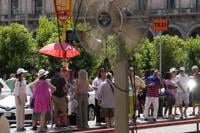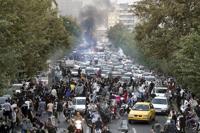AMMAN, Jordan (AP) — As Jordan hosted regional talks this spring aimed at ending Syria’s isolation after more than a decade of civil war, Syrian refugee Suzanne Dabdoob felt a deep pressure in her brain and in her ears, she said, a fear she hadn’t felt since arriving to Jordan 10 years ago.
Ahead of the meeting, Syrian President Bashar Assad agreed that 1,000 Syrian refugees living in Jordan would be allowed to safely return home — a test case for the repatriation of far greater numbers. Jordan’s top diplomat spoke only of voluntary returns. But panic spread through working-class east Amman, where Dabdoob and many other Syrians have built new lives in multistory, cement-block buildings.
“I would rather die right here than go back to Syria,” said Dabdoob, 37, whose home was razed by airstrikes in the Syrian city of Homs.
She fled to Amman with her five children, her accountant husband, who dodged military service, and her sister, who she said is wanted for abandoning her civil service job.
“We are scared that, even indirectly, the Jordanian government will pressure us to leave,” she said.
As Middle East countries strained by vast numbers of refugees , many Syrians who fled are now terrified by the prospect of returning to a country shattered by war and controlled by the same authoritarian leader who brutally crushed the 2011 rebellion.
Even as public hostility and economic misery in neighboring countries has squeezed Syrian refugees, few are clamoring to return. The number of registered Syrian refugees in Jordan, Turkey and Lebanon has remained roughly the same for the last seven years, according to U.N. figures.
Hoping to speed up their exodus, Lebanon and Turkey have deported hundreds of Syrians since April in what rights groups consider a violation of international law.
Now Jordan, a close American ally generally praised for its acceptance of millions of Palestinian, Iraqi and Syrian refugees, .
The “Jordan Initiative” unveiled in May to encourage cooperation with Assad on refugee returns and illicit drug trafficking capped the country’s painful transformation, advocates say, from one of the world’s most accommodating hosts to one of its biggest proponents for sending refugees home.
“Jordan long has said that refugees are welcome. But now the official rhetoric has moved toward supporting their return,” said Adam Coogle, deputy director of the Middle East and North Africa division at Human Rights Watch. “It’s a cause for significant concern.”
Human rights groups say it’s still too unsafe for refugees to return to Syria given the risks of arbitrary detention, disappearance and extrajudicial killings there. Even the most fortunate returnees encounter bread lines, a currency collapse and electricity shortages after a dozen years of a conflict that has killed nearly half a million people and displaced half of its pre-war population of 23 million.
“My family tells me there is no more war, sure, but there is also nothing left,” said Mohammed, a 34-year-old carpenter who fled Syria in 2013 and opened a hand-carved wooden furniture shop in Amman identical to his father’s workshop in Damascus.
Giving only his first name for security reasons, Mohammed said he hoped never to return, citing stories of Syrian security forces arresting returnees to squeeze thousands of dollars in bribes out of their families. His two daughters, 4 and 10, know no other home.
“Here, I know what it’s like to live with dignity,” he said.
With its reputation as a humanitarian hub — an oasis of relative stability in a volatile Middle East — the kingdom currently hosts an estimated 1.3 million of the 5.2 million Syrian refugees spread across the region, according to government figures.
While Jordanian security forces have not ramped up deportation raids in recent months, the government has expelled tens of thousands of Syrians over the years, mostly for alleged crimes or for failing to register with the authorities. As soaring unemployment and inflation stokes anti-refugee feeling among Jordanians and the government speaks more openly about returns, that history now alarms the country’s Syrian refugees.
“Almost all of us know someone who was kicked out for a reason we don’t understand,” said Dadoob, whose friend, she said, was shot and killed by government forces in the southern Syrian city of Daraa after being deported in 2016. Jordanian security forces accused him, and many others, of communication with extremist and opposition groups in Syria, according to rights groups.
“With the overreach of security services in Jordan and in the region, there’s a lot of distrust now,” said Samer Kurdi from the Collateral Repair Project, which provides aid to refugees in Amman. “The re-embracing of Assad doesn’t make sense to Syrians here.”
Since Assad attended his first annual Arab League summit in 13 years this spring, Jordanian Foreign Minister Ayman Safadi has described his country’s hopes for refugee returns as an inevitable result of Assad’s rehabilitation.
For Jordan, a large displaced population lingering in the country for generations raises the sobering prospect of the country’s 2.2 million Palestinians.
The experience of those refugees, whose families fled or were pushed out during the war surrounding Israel’s creation in 1948, has taught Jordan that the longer refugees stay, the less likely they are to return, said Hassan Momani, professor of international relations at University of Jordan.
“There’s this fear in Jordan’s collective memory,” he said.
Jordan’s foreign and information ministries declined to comment on the issue of Syrian refugee returns, pointing only to recent public statements.
“We are way above our capacity. We ring the alarm,” Safadi told a conference on Syria in Brussels last month.
Earlier this month, he visited Damascus and held talks with Assad. “What we are sure of is that refugees’ futures lie in their country,” he said.
Few Syrians who fled the war for Jordan appear to agree. Just a small number of Syrian refugees in Jordan are voluntarily returning home: 4,013 people in 2022, down from 5,800 in 2021, according to United Nations figures.
A U.N. refugee agency survey of some 3,000 Syrian refugees across the region in February found that just 1.1% of refugees intend to return to Syria in the next year even as most say they harbor hope to return one day. Among respondents in Jordan, just 0.8% said they intended to return in the coming year.
“This is an important indication that right now, today, conditions are not conducive for returns,” said Dominik Bartsch, the UNHCR representative to Jordan.
Even as the Jordanian government insists that all refugee returns will be optional, the line between voluntary and forced return can be blurry.
After 2016, when Jordan shut its border with Syria following a cross-border suicide attack, authorities refused to let Syrians who had left briefly enter back into Jordan. In other cases, refugees were deported for alleged work violations, and then their relatives who followed them to Syria because of their loss of income were registered as voluntary returnees.
“What we see now, 12 years on, is that most of the Syrians in Jordan who really want to return are elderly,” said Kurdi, the local advocate. “They return to die.”










































